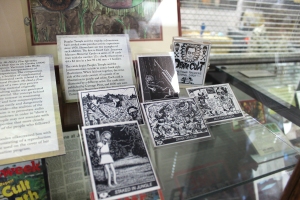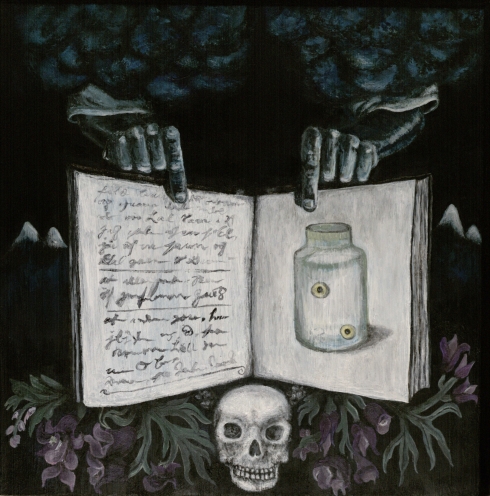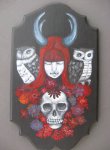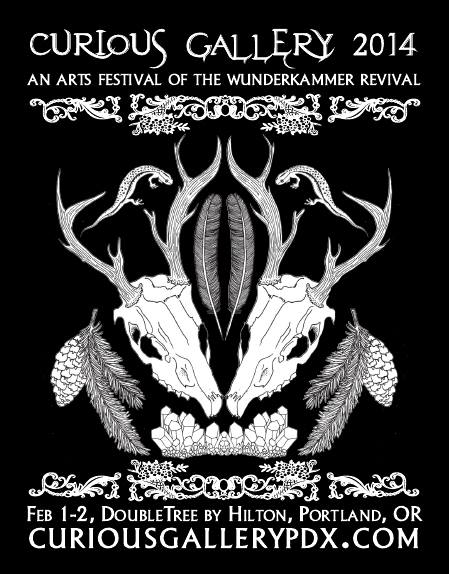You are currently browsing the category archive for the ‘Art’ category.
New exhibit at San Diego State University Special Collections & University Archives!
Peoples Temple at Jonestown: Interpretations of Jonestown in Art, Photography, Sound, Film, and Words is currently on display in the Louis Kenney Reading Room of Special Collections.
Highlighting these various works shows how the Peoples Temple movement of the 1960s and ’70s and the Jonestown tragedy that ended it have informed and influenced artists working in a variety of media to interpret the events. The exhibit seeks to show that the Jonestown tragedy has been interpreted and perceived by artists and others in ways far different than has so often been portrayed in the media. The exhibit also focuses on the kinds of artistic works that use Jonestown as the point of departure for explorations that extend beyond the events themselves.
Works on display in the exhibit come from the Peoples Temple Collection in Special Collections, the collections of the Jonestown Institute in San Diego, and the collection of Jonestown survivor Laura Johnston Kohl. Read more at: /tinyurl.com/qbu54ec
I’ve been a little quiet over the past few months. Busy with instruction and an exhibit. More on that later. In the meantime, I’m headed to the Esoteric Book Conference, where I’m one of the featured artists, as part of a group of eccentric scholars.
http://esotericbookconference.com/
Two paintings especially for the event. Additionally, I’ll have prints of two other works, as well as a few postcards.
New blog post at San Diego State Special Collections & University Archives: http://library.sdsu.edu/scua/new-notable/lifting-veil-abolishing-censorship-vatican.
The Vatican kept a list of forbidden books?!!!! Yes, they did! However, this past week in history on June 14th, 1966, the Catholic Church lifted the final restriction on banned books from the Index Librorum Prohibitorum or the “List of Prohibited Books.”
The Index, as it is informally known, was a list of publications the Catholic Church deemed as either heretical, anti-clerical or immoral, and subsequently banned. The first version was published in 1559, under Pope John IV. The 20th and final edition appeared in 1948, and the Index was formally abolished on June 14, 1966 by Pope Paul VI. The list was designed to prevent faithful followers of the Catholic Church and its constituents from reading material bent on questioning or challenging Catholic ethics or morality, as determined by the Holy See.
San Diego State’s Special Collections is fortunate to house two editions of the Index Librorum Prohibitorum: the 1758 edition, nearing the end of Pope Benedict XIV’s pontification, and the 1835 edition under Pope Gregory XVI. By 1948, the list contained over 5,000 titles, many of which included single works of authors and in some cases, an entire bibliography of a single author. Many fundamental astronomy books, including the work of Galileo, Kepler, and Copernicus were originally included on the list immediately after publication, although later lifted. Special Collections also holds the Historic Astronomy Collection which includes the works of Galileo and Copernicus, originally banned for their defense and theories about “heliocentrism” or the astronomical model in which the Earth and planets revolve around the Sun at the center of the Solar System. The idea of heliocentrism, at the time, was not supported by the Church.
Other authors within SCUA’s collection found in the Index, include the controversial religious scholar and Catholic priest, Martin Luther, a sermon from 1520, basically refusing to redact his writings, Victor Hugo’s radical working class and anti-authoritarian views in the Hunchback of Notre Dame, 1836 edition, and Madame Staël’s proto-feminist, Romantic political views in Delphine and Corinne.
A complete list of banned authors and books listed in the Index Librorum Prohibitorum, 1948 is found here: http://www.cvm.qc.ca/gconti/905/BABEL/Index%20Librorum%20Prohibitorum-1948.htm
Curated by Iris Bechtol and Josh Rose, No Restraint: Activist Zines and Comics focuses on the social, political, and cultural issues addressed in comics and zines. Though inherently independent and residing near the edge of society, zines and indie comics have the power to inform, influence, and perhaps change our perceptions. Their subject matter, whether fantastic narratives, autobiographical accounts, partially fictitious, or resounding socio-political statements, zines and indie comics are a unique voice that is often more real than mainstream media. Ranging from activist literature to autobiographical explorations, this exhibition includes original drawings, comics, and zines by Marta Chudolinska (Babica), Gord Hill (The 500 Years of Resistance), Nia King, Kate Lavut (Chico), Noah Lyon (America the Conspiracy), Stephanie McMillan (Minimum Security), Margarat Nee (Grrrl Zines a Go Go), Simon Orpana (The Art of Gentrification), Kim Schwenk (Grrrl Zines a Go Go), Elizabeth Simins (Manic Pixel Dream Girl), Sarah Welch (Endless Monsoon), Lisa Wilde (Yo, Miss), and select works from the Zine Project Seattle.
http://eastfieldgalleries.blogspot.com/2014/04/no-restraint-activist-zines-and-comics.html
Eastfield College is a community college of the Dallas County Community College District, located in Mesquite, Texas
Selection of mythical artworks from 2010-2013.
- Wotan
- Le Secret
- Bidding the Wooden Ships Farewell
- Jagerkrieg
- Fate of the Norns
- Kalessia
- A Sun That Never Sets
- La Muerta Roja
- Winter of the Wind
Abstract:
The elixir, both alchemical and pharmaceutical, has a long history of wonder and controversy dating back to Babylonia. Derived from both Greek and Arabic origination, the prepared elixir is steeped in magical tradition, as well as, legitimate apothecial uses. Elixir, or in Greek in medical terms, meaning “any dry powder” is mysterious, resulting from the cross-over of science and spagyrics, or the process of making herbal medicines using alchemical processes. Many of the apothecaries, like Michel de Nostredame, utilized elixirs magically, cosmetically, and medically. This presentation uncovers a few historical formulas and provides a quick demonstration on modern elixir making.
I’m submitting a proposal for a presentation this year at the Curious Gallery PDX in February 2014. Here’s to fun times! http://www.curiousgallerypdx.com/
Rafaela Drazic, Ad Hoc Project
Softcover, 140 pp., offset 1/1, 155 x 220 mm
English and Croatian
Edition of 100
Published by Rafaela Drazic
Secret Exhibitions project sheds a light on the complicated mechanisms of censorship and destruction within the context of visual arts, which were developed as a part of the processes of post-socialist transformations. The project functions as an interdisciplinary platform of curators, artists, historians and art historians who dealt with the topic of censorship or faced it directly. Project has an emphasized arbitrary nature.
Ana Krsinic Lozica, Distribution, Irena Boric, Ivana Hanacek, Kim Schwenk, Lina Kovacevik, Magdalena Frankowska, Marco Ugolini, Pierre Maite, Rafaela Drazic, Rene Zieger, Robert Canak, Slang International, Slava and Tatars, Stefan Haus, Tomoko Yoneda, Verena Gerlach































